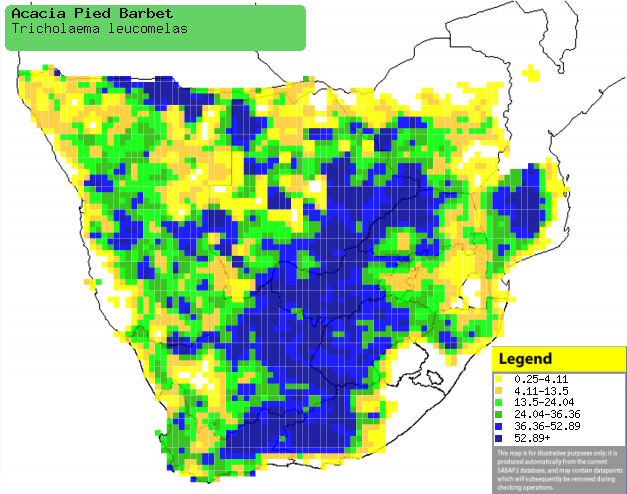|
Tricholaema leucomelas (Acacia
pied barbet, Pied barbet)
Bonthoutkapper [Afrikaans]; Sikuta (name also applied to
Yellow-fronted tinkerbird) [Kwangali]; Serokolo [South Sotho]; Mogôrôsi
[Tswana]; Kaapse baardvogel [Dutch]; Barbican pie [French]; Rotstirn-bartvogel
[German]; Barbaças-das-acácias [Portuguese]
Life
> Eukaryotes >
Opisthokonta
> Metazoa (animals) >
Bilateria >
Deuterostomia > Chordata >
Craniata > Vertebrata (vertebrates) > Gnathostomata (jawed
vertebrates) > Teleostomi (teleost fish) > Osteichthyes (bony fish) > Class:
Sarcopterygii (lobe-finned
fish) > Stegocephalia (terrestrial
vertebrates) > Tetrapoda
(four-legged vertebrates) > Reptiliomorpha > Amniota >
Reptilia (reptiles) >
Romeriida > Diapsida > Archosauromorpha > Archosauria >
Dinosauria
(dinosaurs) > Saurischia > Theropoda (bipedal predatory dinosaurs) >
Coelurosauria > Maniraptora > Aves
(birds) > Order: Piciformes >
Family: Lybiidae
The Acacia pied barbet is nearly endemic to southern Africa,
as
its range extends marginally into Angola and Zambia. It mainly occurs in
semi-arid savanna, but it has recently colonised grasslands, fynbos, orchards
and suburban gardens, due to the introduction of alien tree species, especially
Acacia. It feeds mainly on fruit, as well as insects, Aloe nectar
and flower petals. Both sexes excavate the nest, which is a chamber dug into the
underside of dead branches, laying 2-4 eggs, which are incubated by both sexes,
for 12-18 days. The chicks stay in the nest for about 35 days, and are fed by
both parents.
Distribution and habitat
Nearly endemic to southern
Africa, marginally extending into Angola and Zambia. It is common in Namibia, Botswana, Zimbabwe,
southern Mozambique and South Africa. It generally prefers semi-arid savanna,
but in the past century it has colonised grasslands, fynbos, orchards and suburban gardens, due
to the introduction of alien tree species, especially Acacia.
|
 |
|
Distribution of Acacia pied barbet in southern Africa,
based on statistical smoothing of the records from first SA Bird Atlas
Project (©
Animal Demography unit, University of
Cape Town; smoothing by Birgit Erni and Francesca Little). Colours range
from dark blue (most common) through to yellow (least common).
See here for the latest distribution
from the SABAP2. |
Brood parasites
It has been recorded as host of the
Lesser honeyguide.
Food
It feeds mainly on fruit, as well as
insects, Aloe nectar and flower petals. The following food items have
been record in its diet:
- Plants
- fruit
- mistletoes
- Ficus (wild figs)
- Boscia (shepherds-trees)
- Rhus (karees)
- Euclea (guarris)
- Phoenix reclinata (Wild date palm)
- apples
-
Aloe
nectar
- petals of Homeria pallida (Yellow iris)
- seedpods of Sophora japonica (alien Japanese pagoda)
- Insects
Breeding
- Both sexes excavate the nest, which is a chamber
dug into the underside of a dead branch. The following trees are used as
nest sites:
- Acacia
- Euphorbia
- Aloe dichotoma (Quiver-tree)
- Ziziphus (jujubes)
- Salix (willows)
- Egg-laying season is from August-April.
- It lays 2-4 eggs, which are incubated by both sexes for 12-18 days.
- The chicks stay in the nest for about 35 days, and are fed by both
parents.
Threats
Not threatened, in fact has taken advantage of the
increasing amount of alien trees, which it uses as nesting sites. This has
caused its range and population to increase recently.
References
-
Hockey PAR, Dean WRJ and Ryan PG (eds) 2005. Roberts
- Birds of southern Africa, VIIth ed. The Trustees of the John Voelcker
Bird Book Fund, Cape Town.
|
